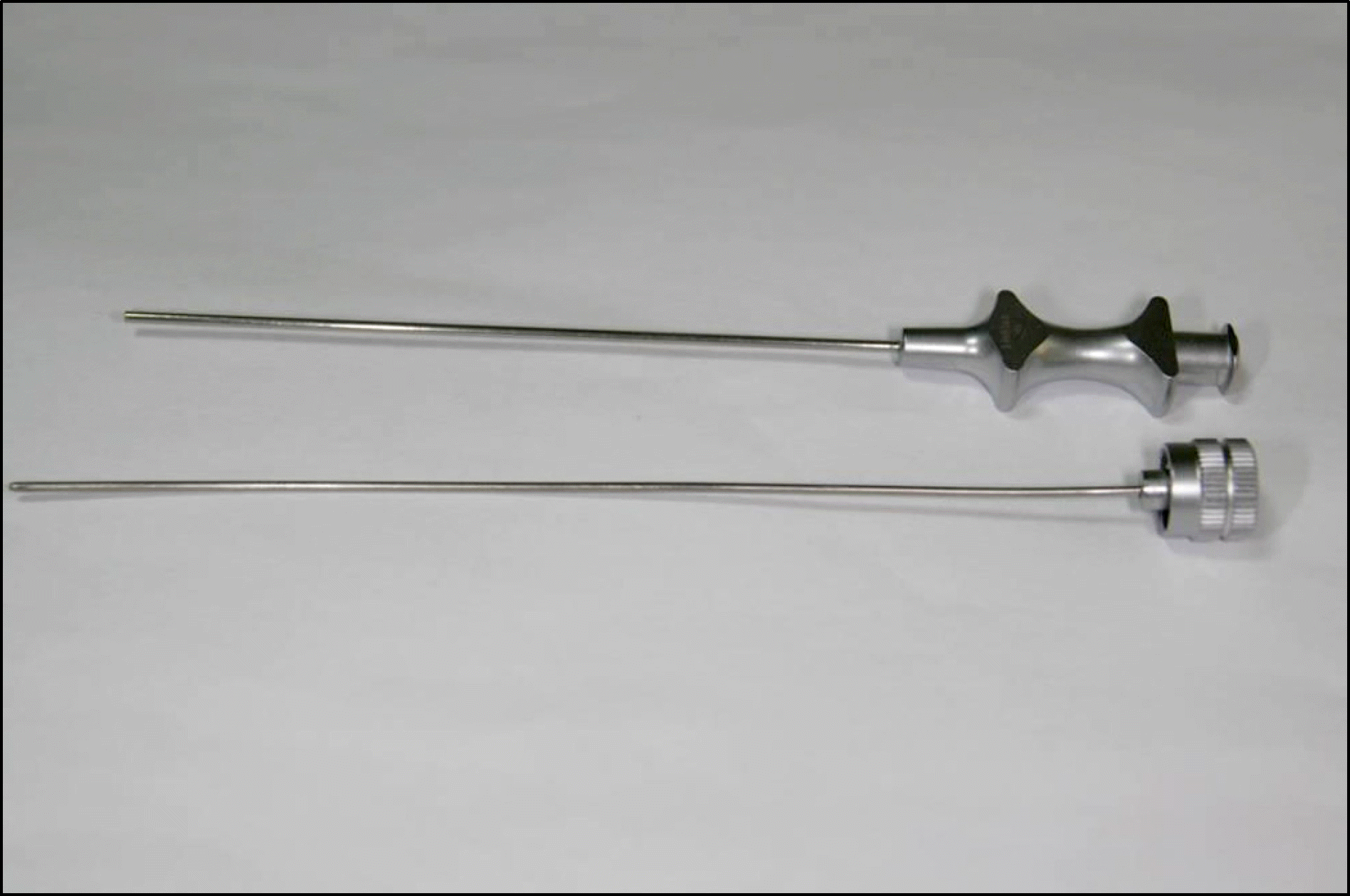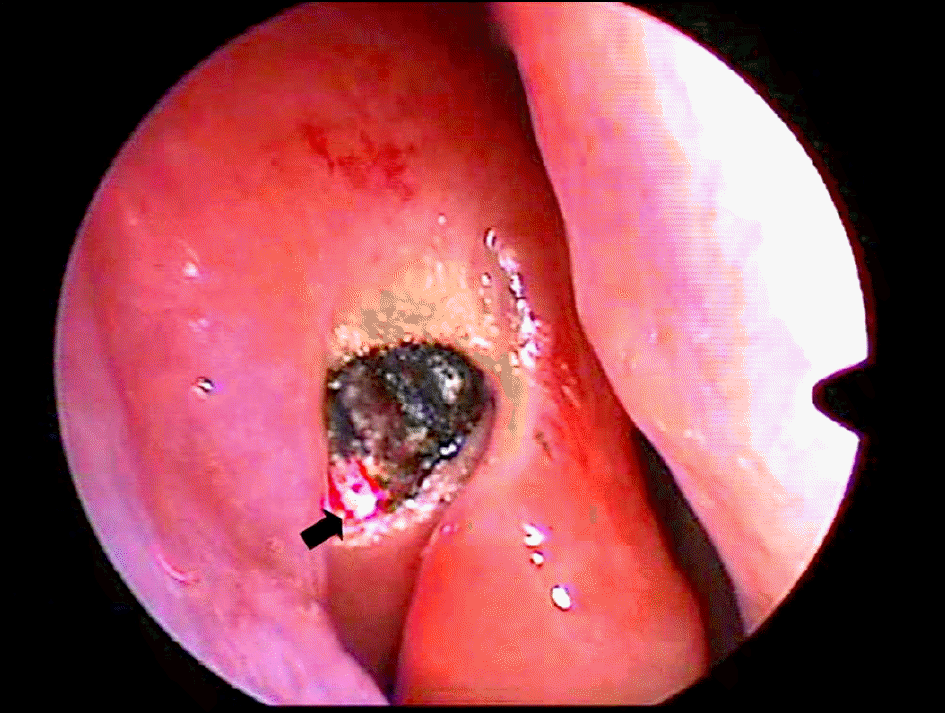Abstract
Purpose
This study evaluated the clinical outcomes of transcanalicular laser-assisted dacryocystorhinostomy (TCL-DCR) using a diode laser in patients with nasolacrimal duct obstruction (NLDO).
Methods
A total of 71 patients (76 eyes) who underwent TCL-DCR between May 2004 and April 2010 were analyzed. The functional and anatomic success rates were evaluated and the causes of failure were analyzed.
Results
The anatomic and functional success rates in primary TCL-DCR were 73.9% (51 of 69 eyes) and 62.3% (43 of 69), respectively. The causes of failure were membranous obstruction in 50.0% of the cases, granuloma formation in 38.9%, synechia formation in 5.6%, and canalicular stenosis in 5.6%. The anatomic and functional success rates were both 42.9% (3 of 7eyes) after TCL-DCR revision.
Conclusions
The success rate of TCL-DCR is relatively comparable to that of conventional surgery. Additionally, the advantages of the procedure are its minimal invasiveness and convenience in an outpatient setting, suggesting that TCL-DCR may be an effective procedure for primary and secondary NLDO.
Go to : 
References
1. Levin PS, StormoGipson DJ. Endocanalicular laser-assisted dacryocystorhinostomy. An anatomic study. Arch Ophthalmol. 1992; 110:1488–90.
2. Pearlman SJ, Michalos P, Leib ML, Moazed KT. Translacrimal transnasal laser-assisted dacryocystorhinostomy. Laryngoscope. 1997; 107:1362–5.

3. Lee TS, Kim JS, Jo SH, Choe JS. The surgical results of Transcanalicular laser-assisted dacryocystorhinostomy. J Korean Ophthalmol Soc. 2004; 45:1–7.
4. Dalez D, Lemagne JM. Transcanalicular dacryocystorhinostomy by pulse Holmium-YAG Laser. Bull Soc Belge Ophthalmol. 1996; 263:139–40.
5. Hofmann T, Lackner A, Muellner K, et al. Endolacrimal KTP Laser assisted dacryocystorhinostomy. Arch Otolaryngol Head Neck Surg. 2003; 129:329–32.
6. Alañón Fernández FJ, Alañón Fernández MA, Martínez Fernández A, Cárdenas Lara M. Transcanalicular dacryocystorhinostomy technique using diode laser. Arch Soc Esp Oftalmol. 2004; 79:325–30.
7. Dolman PJ. Comparison of external dacryocystorhinostomy with nonlaser endonasal dacryocystorhinostomy. Ophthalmology. 2003; 110:78–84.

8. Tsirbas A, Davis G, Wormald PJ. Mechanical endonasal dacryocystorhinostomy versus external dacryocystorhinostomy. Ophthal Plast Reconstr Surg. 2004; 20:50–6.

9. Mirza S, Al-Barmani A, Douglas SA, et al. A retrospective comparison of endonasal KTP laser dacryocystorhinostomy versus external dacryocystorhinostomy. Clin Otolaryngol Allied Sci. 2002; 27:347–51.

10. Yung MW, Hardman-Lea S. Analysis of the results of surgical endoscopic dacryocystorhinostomy: effect of the level of obstruction. Br J Ophthalmol. 2002; 86:792–4.

11. Durvasula VS, Gatland DJ. Endoscopic dacryocystorhinostomy: long term results and evolution of surgical technique. J Laryngol Otol. 2004; 118:628–32.
12. Nussbaumer M, Schreiber S, Yung MW. Concomitant nasal procedures in endoscopic dacryocystorhinostomy. J Laryngol Otol. 2004; 118:267–9.

13. Massaro BM, Gonnering RS, Harris GJ. Endonasal laser dacryosystorhinostomy. A new approach to nasolacrimal duct obstruction. Arch Ophthalmol. 1990; 108:1172–6.
14. Kim JH, Shin JC. Clinical evaluation of endoscopic transnasal dacryocystorhinostomy. J Korean Ophthalmol Soc. 1997; 38:1706–11.
15. Lee TS, Kim SW, Park BW. The relationship between rate of wound healing and success rate after endonasal Laser-drill assisted dacryocystorhinostomy. J Korean Ophthalmol Soc. 1999; 40:2969–74.
16. Yang SW, Lee DP, Choi WC. The relation between nasal cavity size and success rate in endonasal dacryocystorhinostomy. J Korean Ophthalmol Soc. 2000; 41:1118–23.
17. Park JD, Kim YI, Shin SG. The factors related to surgical success rate of endonasal dacryocystorhinostomy. J Korean Ophthalmol Soc. 1998; 39:2848–53.
18. Patel BC, Phillips B, McLeish WM, et al. Transcanalicular Neodymium: YAG laser for revision of dacryocystorhinostomy. Ophthalmology. 1997; 104:1191–7.

19. Woo KI, Moon SH, Kim YD. Transcanalicular laser-assisted revision of failed dacryocystorhinostomy. Ophthalmic Surg Lasers. 1998; 29:451–5.

Go to : 
 | Figure 1.Catheter used for TCL-DCR. TCL-DCR = transcanalicular diode-laser assisted dacryocystorhinostomy. |
 | Figure 2.Intranasal view during TCL-DCR using diode laser (Black arrow shows Laser probe tip). TCL-DCR = transcanalicular diode-laser assisted dacryocystorhinostomy. |
Table 1.
Functional and anatomic success rates of primary TCL-DCR and TCL-DCR revision after failure
| | Primary TCL-DCR | First revision TCL-DCR | Second revision TCL-DCR |
|---|---|---|---|
| Functional | 62.3% (43/69) | 55.6% (10/18) | 66.6% (2/3) |
| Anatomic | 73.9% (51/69) | 72.2% (13/18) | 100.0% (3/3) |




 PDF
PDF ePub
ePub Citation
Citation Print
Print


 XML Download
XML Download